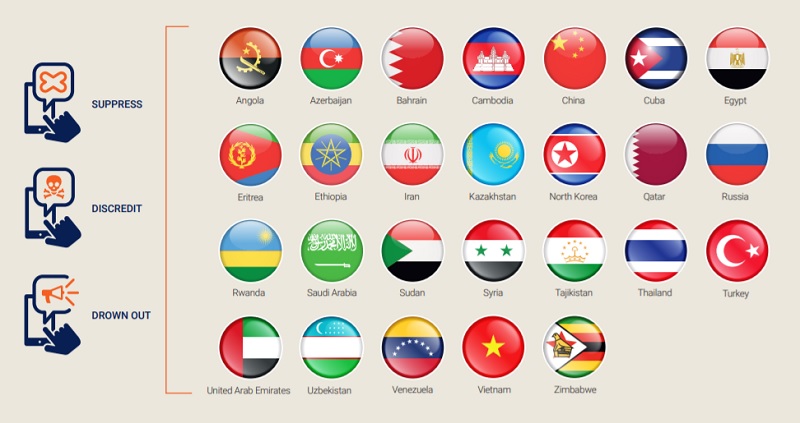
A report released by researchers at Oxford University‘s Oxford Internet Institute revealed that the number of governments using social media manipulation campaigns has nearly doubled this year.
Oxford’s Samantha Bradshaw and Philip Howard have monitored how governments and political parties manipulate social media for the past three years. Their study includes analysis of the computational propaganda trends and the evolution of tools, strategies, and resources used by these parties.
In the past two years alone, the researchers reported a 150 percent increase in the countries using organized social media manipulation campaigns. From just 28 last 2017, the number of countries rose to 70 this 2019, up by 22 from last year’s 48 countries.
The team wrote in their “2019 Global Inventory of Organized Social Media Manipulation” report:
“Although propaganda has always been a part of political discourse, the deep and wide-ranging scope of these campaigns raise critical public interest concerns.”
Computational Propaganda: Social Media Manipulation
In a separate paper published in the Oxford Scholarship Online, Howard and his co-author Samuel Woolley described computational propaganda as a new form of political manipulation that takes place over the Internet.
“The term describes the assemblage of social media platforms, autonomous agents, algorithms, and big data tasked with the manipulation of public opinion,” the researchers noted.
In their recent report, Howard and Bradshaw examined the formal organization of cyber troops (government or political party actors that uses social media manipulation to shape public opinion) globally, and how they boost their political objectives using computational propaganda.
The researchers found evidence of social media manipulation campaigns in 70 countries which include Australia, China, Germany, India, Israel, Malaysia, North and South Korea, Malaysia, Philippines, Russia, Saudi Arabia, Turkey, UAE, United Kingdom, and the United States, to name a few.

Some of the political parties this year are allegedly experimenting with the tools and techniques of computational propaganda to control information during elections. Below are the other key findings from the study:
- In each of the 70 countries, there’s one political party or government agency that uses social media to influence public attitudes domestically.
- Authoritarian regimes use social media as a tool of information control in three distinct ways: to suppress fundamental human rights, discredit political opponents, and drown out dissenting opinions.
- Advanced state actors use computational propaganda for foreign influence operations. Facebook and Twitter named seven countries who use social media to influence their global audience. The list includes China, India, Iran, Pakistan, Russia, Saudi Arabia, and Venezuela.
- China is now a major player in the global disinformation order, using computational propaganda in Internet platforms like Weibo, WeChat, and QQ.
- Facebook is still the favorite platform for social media manipulation in 56 countries.

Computational Propaganda Strategies, Tools, and Techniques

The Oxford researchers also found that sophisticated actors use fake accounts to spread disinformation. In the three years they’ve been monitoring these cyber troops, Howard and Bradshaw were able to track the prevalence of three kinds of fake accounts: bot, human, and cyborg.
Evidence suggests that bot accounts have been used in 50 countries, while human fake accounts used for posting comments or tweets have been heavily utilized in 60 countries. The researchers noted that the cyborg accounts, which merged automation with human curation, were also found to be used in computational propaganda.
Cyber troops also use stolen or hacked accounts as part of their online propaganda campaigns. This discovery further emphasized the interconnectivity of computational propaganda with traditional forms of cyberhacking.
According to the report, 71 percent of cyber troops use social media manipulation to spread pro-government or pro-party propaganda, while 89 percent use it to attack their political opponents. The other 34 percent use it as a tool to spread polarizing messages which aim to create social divisions.
The researchers also specified the communication strategies used by these cyber troops. They’ve been categorized into five categories, which include:
- the creation of disinformation of manipulated media;
- mass-reporting of content accounts;
- data-driven strategies;
- trolling, doxing, or harassment;
- amplifying content and media content.
Seventy-five percent of the countries on this year’s list manipulate social media information to mislead people. Sixty-eight percent of the countries use state-sponsored trolling to target political dissidents, while 73 percent amplify their messages and content through flooding hashtags.
The researchers noted that computational propaganda has now become a regular part of the digital public sphere and it will continue to evolve in conjunction with new technologies like artificial intelligence, virtual reality, and the Internet of Things. The researchers concluded:
“A strong democracy requires access to high-quality information and an ability for citizens to come together to debate, discuss, deliberate, empathize, and make concessions. Are social media platforms really creating a space for public deliberation and democracy? Or are they amplifying content that keeps citizens addicted, disinformed, and angry?”



















‘There’s got to be a great line drawn between these crypto scammers and the havoc they are wrecking on their victims. How would have I survived this tragedy of losing almost Six hundred and fifty-eight thousand Pounds to an impostor posing as a Blockchain trade agent? I just can’t stop emphasizing the good deeds of CY-BER GENIE HACK PRO. I don’t want to be like the 10 blind men from the bible who Jesus delivered them but only one came to appreciate his gestures to them. I am posting this review for myself, I am contributing my quota of making the internet the safe place it used to be by referring scammed victims to (CY BERGENIEHACKPRO) on Telegram for assistance in tracing, and high chances of recovering their stolen money. I wish those who had been rescued from fraudsters by Cyber Genie Hack Pro’s team could post their success stories like mine, doing so, they will reach a larger audience thereby creating more awareness that you can recover your stolen money from scammers. My dealings with Cyber Genie were great, I first had my reservations because I had already lost hundreds of thousands worth of crypto coins, but I was thrilled by their engagement to my task of recovering my stolen money. Never give up if you have been scammed, CYB-ER-GE-NIEH-ACK PRO is all you need. You can find them on their WhatsApp also: (+)(1252-512-0391) Mail them on; (cybergenie(@)cyberservices(.)com)’